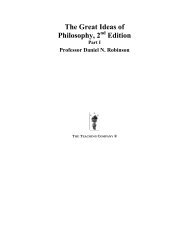English idioms in the first language and second language lexicon: a ...
English idioms in the first language and second language lexicon: a ...
English idioms in the first language and second language lexicon: a ...
Create successful ePaper yourself
Turn your PDF publications into a flip-book with our unique Google optimized e-Paper software.
330 <strong>English</strong> <strong>idioms</strong> <strong>in</strong> <strong>the</strong> L1 <strong>and</strong> L2 <strong>lexicon</strong>figurative mean<strong>in</strong>gs must be stored separately <strong>in</strong> <strong>the</strong> mental <strong>lexicon</strong>,<strong>and</strong> that this mean<strong>in</strong>g must be learnt as a whole unit. This articleargues that <strong>the</strong>se assumptions only apply to a subgroup of <strong>idioms</strong><strong>and</strong> that it is more adequate to th<strong>in</strong>k of <strong>idioms</strong> as be<strong>in</strong>g represented<strong>in</strong> a dual way.For l<strong>in</strong>guistic <strong>the</strong>ories, which are ma<strong>in</strong>ly concerned with literal<strong>language</strong>, <strong>idioms</strong> have always caused serious problems. This is why,over <strong>the</strong> last four decades, l<strong>in</strong>guists <strong>and</strong> psychol<strong>in</strong>guists havedeveloped a number of hypo<strong>the</strong>ses to describe <strong>the</strong> specialgrammatical characteristics of <strong>idioms</strong> <strong>and</strong> to expla<strong>in</strong> <strong>the</strong>irprocess<strong>in</strong>g <strong>and</strong> representation. Although we have ga<strong>in</strong>ed many<strong>in</strong>sights from <strong>the</strong>se studies, <strong>the</strong>re are three aspects that have beenneglected. First, <strong>the</strong> studies deal exclusively with <strong>the</strong> native mental<strong>lexicon</strong> <strong>and</strong> do not try to <strong>in</strong>tegrate <strong>the</strong> <strong>second</strong> <strong>language</strong> (L2)<strong>lexicon</strong>. Secondly, <strong>the</strong> studies concentrate ei<strong>the</strong>r on lexicalrepresentations or on conceptual aspects but do not try to comb<strong>in</strong>e<strong>the</strong> two <strong>in</strong>to one <strong>the</strong>oretical model. Lastly, most of <strong>the</strong> studies donot allow for frequency effects to play a role <strong>in</strong> <strong>the</strong> representationor process<strong>in</strong>g of <strong>idioms</strong>.This article <strong>in</strong>troduces a model that <strong>in</strong>cludes <strong>the</strong>se aspects, <strong>the</strong>Model of Dual Idiom Representation (henceforth <strong>the</strong> DIR Model).It is a psychol<strong>in</strong>guistic model which not only comb<strong>in</strong>es <strong>the</strong> lexical<strong>and</strong> <strong>the</strong> conceptual level but also <strong>in</strong>tegrates <strong>the</strong> representation of<strong>idioms</strong> <strong>in</strong> <strong>the</strong> <strong>first</strong> <strong>language</strong> (L1) <strong>and</strong> <strong>the</strong> L2 <strong>lexicon</strong>. Additionally,it considers frequency effects that <strong>in</strong>fluence <strong>the</strong> representations.Support<strong>in</strong>g evidence for <strong>the</strong> DIR Model comes from empiricalstudies on <strong>the</strong> decomposability of <strong>idioms</strong> with native <strong>and</strong> nonnativespeakers of <strong>English</strong>. Insights <strong>and</strong> results of experimentalmorphological studies are also used to confirm <strong>the</strong> model’sassumptions.The next section briefly reviews psychol<strong>in</strong>guistic idiom research,focus<strong>in</strong>g on hypo<strong>the</strong>ses <strong>and</strong> models of idiom comprehension <strong>and</strong>process<strong>in</strong>g <strong>and</strong> <strong>the</strong> so-called Idiom Decomposition Hypo<strong>the</strong>sis(Gibbs <strong>and</strong> Nayak, 1989). Next, empirical studies on <strong>the</strong>decomposability of <strong>idioms</strong> carried out with native <strong>and</strong> nonnativespeakers of <strong>English</strong> are presented <strong>and</strong> <strong>the</strong> differences between <strong>the</strong>two groups of speakers are compared. The ma<strong>in</strong> assumptions of <strong>the</strong>DIR Model suggest explanations for <strong>the</strong> f<strong>in</strong>d<strong>in</strong>gs. F<strong>in</strong>ally, <strong>the</strong>conclusions summarize <strong>the</strong> central po<strong>in</strong>ts made <strong>in</strong> this article.II Psychol<strong>in</strong>guistic idiom researchOver <strong>the</strong> last few decades, psychol<strong>in</strong>guistic idiom research has beendom<strong>in</strong>ated by several approaches to idiom comprehension <strong>and</strong>Downloaded from http://slr.sagepub.com at Shanghai Jiaotong University on March 7, 2009














